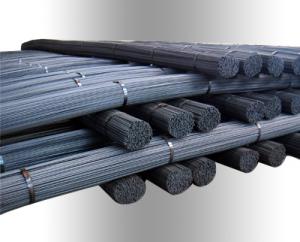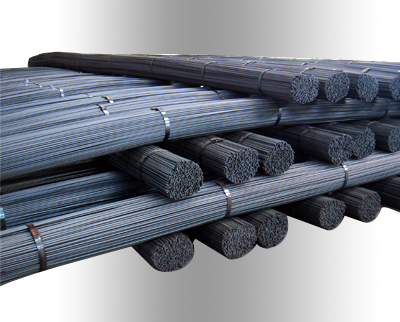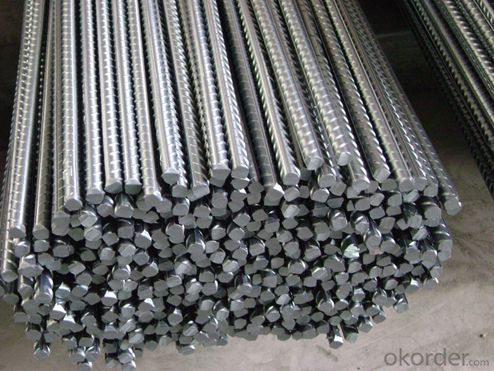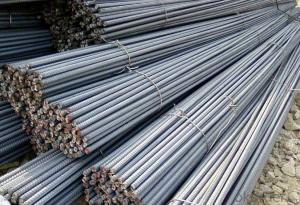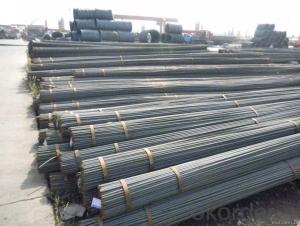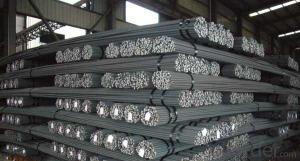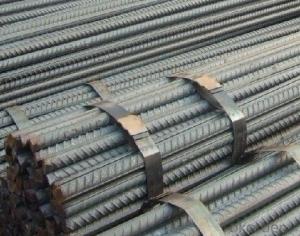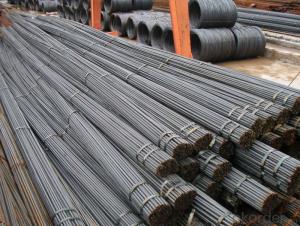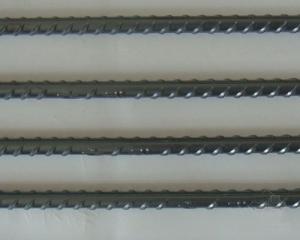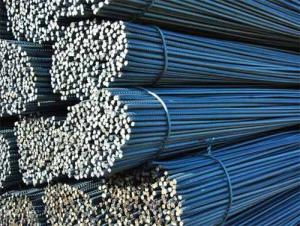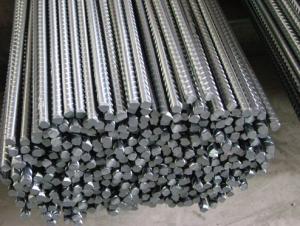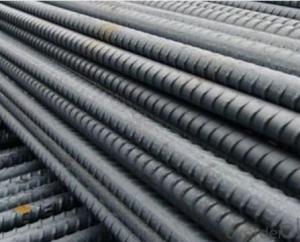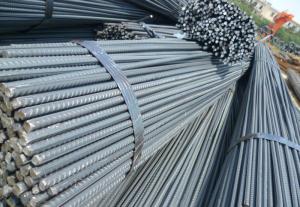Nine mm Cold Rolled Steel Rebars with High Quality
- Loading Port:
- Tianjin
- Payment Terms:
- TT or LC
- Min Order Qty:
- 100 m.t.
- Supply Capability:
- 15000 m.t./month
OKorder Service Pledge
OKorder Financial Service
You Might Also Like
Specifications of Nine mm Cold Rolled Steel Rebars with High Quality:
Name | Cold Rolled Steel Rebar | |
Diameter | 5mm,5.5mm,6mm,6.5mm,7mm,8mm,9mm,10mm, 11mm,12mm, | |
Length | 6M, 9M,12M or as required | |
Price | Keep lower operating costs so as to offer competitive price for our clients | |
Label | to be specified by customer, generally, each bundle has 1-2 labels | |
Application | Building, construction | |
Invoicing | Actual or Theoretical Weight Basis as buyer’s request. | |
Theoretical weight and section area of each diameter of Nine mm Cold Rolled Steel Rebars with High Quality as below for your information:
Diameter(mm) | Section area (mm²) | Mass(kg/m) | Weight of 12m (kg) | Pcs/ton |
9 | 63.6 | 0.499 | 5.988 | 167 |
Packaging & Delivery of Nine mm Cold Rolled Steel Rebars with High Quality:
Packaging Detail: products are packed in bundle and then shipped by container or bulk vessel, deformed bar is usually naked strapping delivery, when storing, please pay attention to moisture proof. The performance of rust will produce adverse effect.
Each bundle weight: 2-3MT, or as required
Payment terms: TT payment in advance or Irrevocable LC at sight.
Trade terms :FOB, CFR, CIF
Delivery Detail: within 45 days after received advanced payment or LC.
FAQ:
Q1: Why buy Materials & Equipment from OKorder.com?
A1: All products offered byOKorder.com are carefully selected from China's most reliable manufacturing enterprises. Through its ISO certifications, OKorder.com adheres to the highest standards and a commitment to supply chain safety and customer satisfaction.
Q2: How do we guarantee the quality of our products?
A2: We have established an advanced quality management system which conducts strict quality tests at every step, from raw materials to the final product. At the same time, we provide extensive follow-up service assurances as required.
Q3: How soon can we receive the product after purchase?
A3: Within three days of placing an order, we will arrange production. The shipping date is dependent upon the quatity, how many sizes you want and the plan of production, but is typically 1 month to 2 month days from the beginning of production.
Images of Nine mm Cold Rolled Steel Rebars with High Quality:
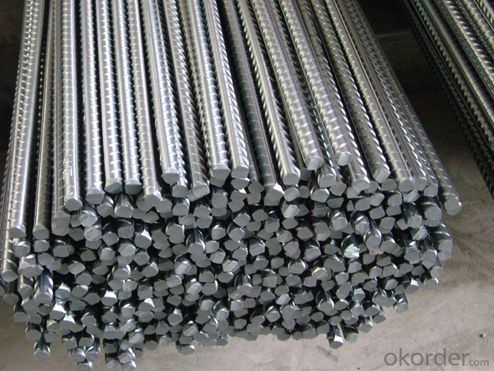
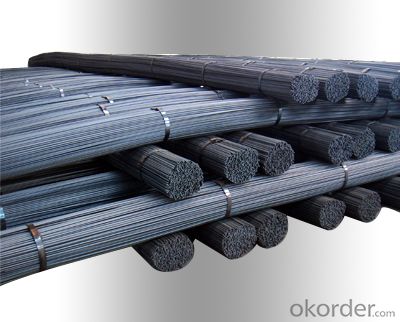
- Q: What are the common defects or issues associated with steel rebars?
- Steel rebars can encounter various defects or issues, including the following: 1. Rust: When exposed to moisture or corrosive substances, steel rebars are prone to rusting. This rust weakens their load-bearing capacity and compromises the structural integrity of the reinforced concrete. 2. Poor bonding with concrete: Inadequate cleaning or the presence of rust can prevent rebars from bonding well with the concrete. This can result in reduced strength and durability of the reinforced concrete structure. 3. Incorrect size or shape: Structural problems can arise from rebars that are improperly sized or shaped. For instance, rebars that are too short or have insufficient coverage might not provide enough reinforcement, making the structure susceptible to cracking or collapse. 4. Improper placement: Weak points in the reinforced concrete can occur due to incorrect rebar placement. This can happen when rebars are not adequately spaced, aligned, or when there are gaps between the rebar and the concrete. 5. Inappropriate storage and handling: To prevent rust, it is crucial to store rebars in a dry and well-ventilated area. Improper storage or handling can lead to surface damage, bending, or twisting of the rebars, affecting their performance in reinforced concrete. 6. Welding defects: Welded rebars may have defects such as insufficient fusion, cracks, or lack of penetration. These defects can compromise the strength and integrity of the reinforcement. 7. Overlapping issues: Overlapping rebars is a common practice to ensure reinforcement continuity. However, improper overlapping, such as insufficient overlap length or inadequate lapping of rebars, can result in weak joints and reduced structural strength. 8. Quality control concerns: Defects or issues in rebars can arise from inadequate quality control during manufacturing or installation. This can encompass problems like improper chemical composition, inadequate strength, or deviations from specified standards. Addressing and rectifying these defects or issues during the design, manufacturing, and construction stages is crucial to ensure the safe and reliable performance of reinforced concrete structures. Regular inspection, maintenance, and adherence to industry standards and guidelines are essential in mitigating these common issues associated with steel rebars.
- Q: How are steel rebars protected during storage and transportation?
- Steel rebars are typically protected during storage and transportation by applying a coating of corrosion-resistant materials, such as epoxy or zinc. Additionally, rebars are often bundled together and securely packaged to prevent damage or shifting during transit.
- Q: How long do steel rebars typically last in construction?
- Steel rebars typically last for the lifespan of the structure they are used in, which can range from 50 to 100 years or more, depending on factors such as environmental conditions, maintenance, and quality of the rebar.
- Q: How do steel rebars affect the overall stability of a structure?
- The overall stability of a structure is greatly impacted by steel rebars, also known as reinforcing bars. These rebars play a crucial role in enhancing the stability and durability of a structure, especially concrete structures. One way in which steel rebars affect the stability of a structure is by strengthening the concrete against tensile forces. While concrete is strong when it comes to compressive forces, it is relatively weak in resisting tension. Steel rebars, with their high tensile strength, help to counteract this weakness by absorbing and distributing tensile forces throughout the structure. This prevents the concrete from cracking or collapsing under excessive tensile loads, resulting in enhanced stability. Furthermore, steel rebars also contribute to the structural stability by improving the flexural strength of a structure. Flexural strength refers to a structure's ability to withstand bending or flexing without deforming or failing. By incorporating steel rebars into reinforced concrete beams, columns, or slabs, the overall flexural strength of the structure increases significantly. This prevents excessive deflection and ensures the structure can bear the various loads it faces, such as the weight of the building, live loads, or external forces. In addition, steel rebars play a vital role in resisting shear forces, which occur when different parts of a structure slide or move in opposite directions. These shear forces can lead to structural failure if not properly addressed. Steel rebars, when correctly positioned and secured, restrain the concrete from shearing, thus preventing potential collapse or instability. Moreover, steel rebars also enhance the stability of a structure by improving its resistance to seismic forces. In areas prone to earthquakes, the inclusion of steel rebars provides the necessary ductility and energy dissipation capacity to withstand seismic activity. Acting as a network of interconnected elements, the rebars distribute the seismic forces and ensure the structure remains stable during an earthquake. In conclusion, steel rebars have a significant impact on the overall stability of a structure. Their inclusion reinforces concrete against tensile forces, enhances flexural strength, resists shear forces, and improves resistance to seismic activity. By increasing the strength, durability, and integrity of a construction, steel rebars ensure that a structure can withstand various loads, forces, and potential hazards, ultimately enhancing its overall stability.
- Q: What are the factors that determine the strength of steel rebars?
- The strength of steel rebars is determined by several factors. Firstly, the composition of the steel used in the manufacture of rebars plays a crucial role. The presence of certain elements, such as carbon, manganese, and silicon, can significantly affect the strength of the steel. These elements enhance the steel's ability to resist tension and provide structural stability, ultimately determining the strength of the rebars. Secondly, the manufacturing process of the rebars has an impact on their strength. The steel is typically heated and then rapidly cooled, a process known as quenching and tempering, which helps in achieving the desired strength. The precise temperature and duration of this process can influence the rebars' strength, as it affects the grain structure and chemical properties of the steel. Thirdly, the size and shape of the rebars also play a role in determining their strength. The diameter and length of the rebar affect its load-bearing capacity. Thicker and longer rebars generally have higher strength as they can withstand greater stress and distribute it more effectively. Furthermore, the presence of any impurities or defects in the steel can weaken the rebars. These defects can include cracks, voids, or inclusions, which can compromise the structural integrity of the rebar and reduce its strength. Lastly, the environment and conditions in which the rebars will be used should also be considered. Factors such as temperature, humidity, and exposure to corrosive substances can impact the rebars' strength over time. Proper precautions, such as using corrosion-resistant coatings or stainless steel rebars, should be taken to ensure the longevity and strength of the rebars in such environments. In conclusion, the strength of steel rebars is determined by the composition of the steel, the manufacturing process, the size and shape of the rebars, the presence of defects, and the environmental conditions in which they will be used. Considering these factors is crucial for ensuring the durability and reliability of steel rebars in construction applications.
- Q: Can steel rebars be used in seismic-resistant structures?
- Yes, steel rebars can be used in seismic-resistant structures. Steel rebars have excellent tensile strength and ductility, making them an ideal reinforcement material for concrete structures in earthquake-prone areas. When properly designed and installed, steel rebars can help increase the structural integrity and resistance of buildings to seismic forces. They provide additional strength and flexibility to the concrete, allowing it to better withstand the lateral and vertical loads exerted during an earthquake. Moreover, steel rebars can effectively dissipate and absorb the energy generated during seismic events, reducing the potential for structural damage or collapse.
- Q: How are steel rebars anchored into existing concrete?
- Steel rebars are commonly used to reinforce existing concrete structures. The process of anchoring steel rebars into existing concrete involves several steps. First, the concrete surface needs to be prepared. This typically involves cleaning the area where the rebar will be anchored to remove any dirt, debris, or loose concrete. The surface may also need to be roughened to provide better adhesion. Once the surface is prepared, a bonding agent such as epoxy or a cementitious grout is applied. This bonding agent helps to create a strong bond between the rebar and the concrete. Next, the steel rebar is positioned and inserted into the prepared area. The length of the rebar that is inserted into the concrete depends on the required anchorage depth and the design specifications. The rebar should be positioned at the correct depth and aligned according to the structural requirements. To ensure proper anchorage, the rebar is often bent or hooked at the end. This helps to prevent the rebar from pulling out of the concrete under tension or other external forces. Finally, the bonding agent is left to cure according to the manufacturer's instructions. This allows the bonding agent to harden and form a strong bond between the rebar and the concrete. It is important to note that the exact method of anchoring steel rebars into existing concrete may vary depending on the specific application and design requirements. In some cases, additional reinforcement methods such as mechanical anchors or post-installed anchors may be used to enhance the anchorage strength. Professional expertise and adherence to engineering guidelines are crucial to ensure the proper and safe anchoring of steel rebars into existing concrete structures.
- Q: How do steel rebars help in load distribution within a structure?
- Steel rebars help in load distribution within a structure by providing reinforcement and strength to the concrete. They are embedded within the concrete to enhance its tensile strength and prevent cracking or failure under heavy loads. The rebars act as a framework, distributing the applied load across a larger area and reducing stress concentrations, thereby ensuring the stability and durability of the structure.
- Q: What are the different types of steel rebars used in marine construction?
- There are several different types of steel rebars commonly used in marine construction projects. These types of rebars are specifically designed to withstand the harsh conditions and corrosive environments typically found in marine structures. 1. Stainless Steel Rebars: These rebars are made of high-grade stainless steel, which contains chromium and nickel. Stainless steel rebars offer excellent resistance to corrosion and are commonly used in marine construction where exposure to saltwater and other corrosive elements is expected. They are more expensive than other types of rebars but provide superior durability and longevity. 2. Epoxy-Coated Rebars: Epoxy-coated rebars are carbon steel rebars that have been coated with an epoxy layer. This coating acts as a protective barrier, preventing the steel from coming into contact with corrosive elements and reducing the risk of rust and corrosion. Epoxy-coated rebars are commonly used in marine construction projects where saltwater exposure is high. 3. Galvanized Rebars: Galvanized rebars are carbon steel rebars that have been hot-dip galvanized. This process involves coating the steel with a layer of zinc, which provides excellent corrosion resistance. Galvanized rebars are commonly used in marine construction projects where exposure to seawater or salt spray is expected. 4. Fiberglass Rebars: Fiberglass rebars are made of high-strength glass fibers embedded in a polymer matrix. These rebars offer excellent resistance to corrosion, as they are not affected by saltwater or other corrosive elements. Fiberglass rebars are lightweight, non-magnetic, and have a high tensile strength, making them suitable for marine construction projects. 5. Carbon Steel Rebars: Carbon steel rebars are the most common type of rebars used in construction, including marine projects. While they are not inherently resistant to corrosion, they can be treated with protective coatings, such as epoxy or galvanization, to enhance their durability and resistance to corrosive environments. It is important to consider the specific requirements and conditions of a marine construction project when selecting the appropriate type of steel rebars. Factors such as exposure to saltwater, humidity, and the expected lifespan of the structure should be taken into account to ensure the longevity and safety of the marine structure.
- Q: How are steel rebars measured and priced?
- Steel rebars are typically measured and priced based on their length, thickness, and weight. The length is measured in feet or meters, and the thickness is measured in inches or millimeters. The weight is usually given in pounds or kilograms. The pricing of steel rebars depends on current market conditions, including factors such as supply and demand, raw material costs, and manufacturing expenses. Additionally, any additional processing or customization requested by the customer may also impact the final price.
Send your message to us
Nine mm Cold Rolled Steel Rebars with High Quality
- Loading Port:
- Tianjin
- Payment Terms:
- TT or LC
- Min Order Qty:
- 100 m.t.
- Supply Capability:
- 15000 m.t./month
OKorder Service Pledge
OKorder Financial Service
Similar products
Hot products
Hot Searches
Related keywords
